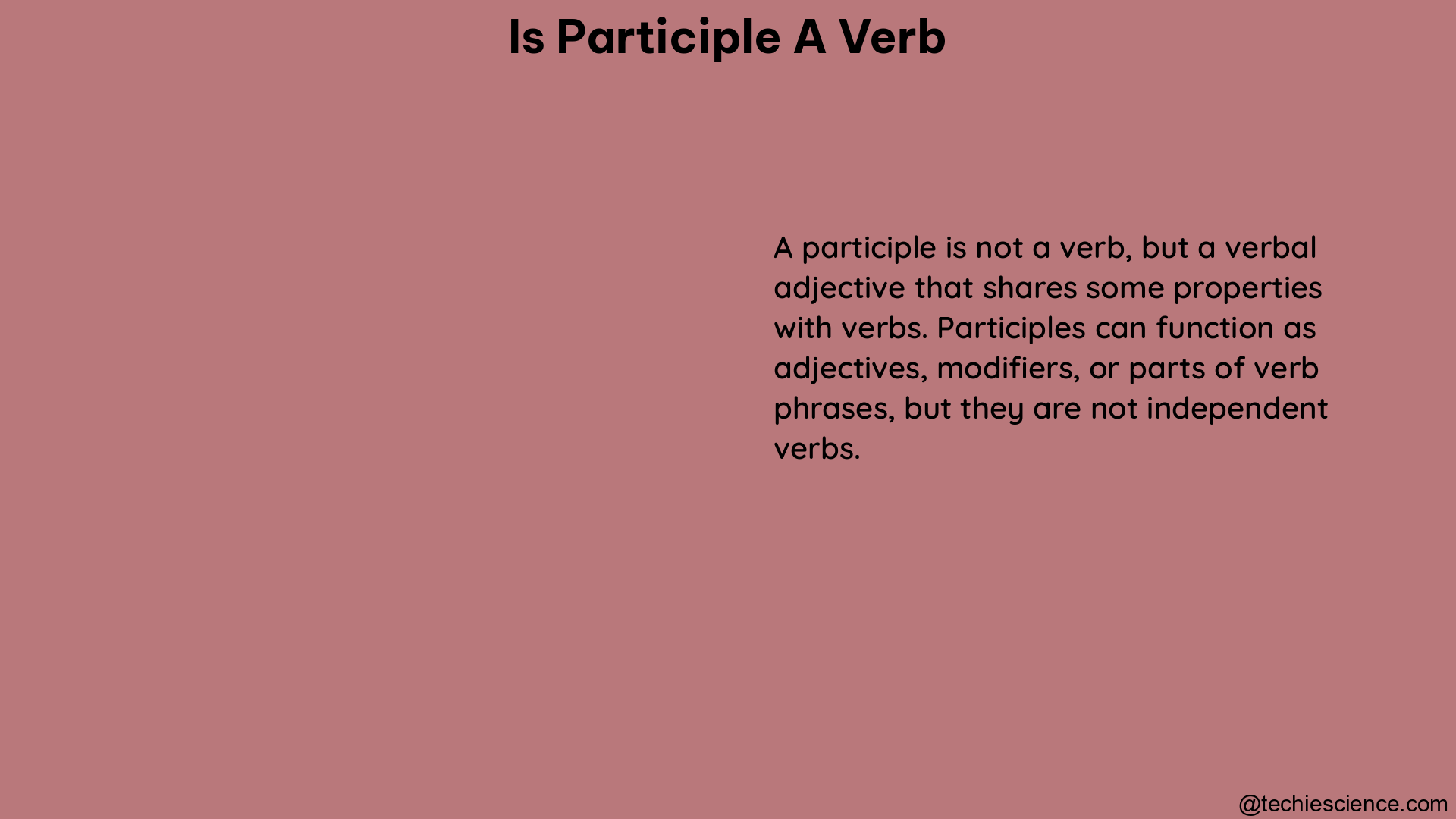Participles are a unique grammatical construct that can function as both verbs and adjectives, making them a crucial component of the English language. Understanding the intricacies of participles is essential for mastering English grammar and effectively communicating through written and spoken language.
Definition and Purpose of Participles
A participle is a verbal form derived from a verb that can serve two primary functions:
- Adjective Function: Participles can modify nouns, similar to adjectives. For example, “the running otter” or “the hidden treasure.”
- Verb Tense Formation: Participles are used to form various verb tenses, such as the present perfect tense (e.g., “I have eaten”) and the continuous tense (e.g., “I am eating”).
Types of Participles

There are two main types of participles in the English language:
Present Participle
Present participles are formed by adding the suffix “-ing” to the base form of a verb. They are used to:
- Form continuous verb tenses (e.g., “I am running.”)
- Function as adjectives to describe nouns (e.g., “The singing bird is beautiful.”)
Examples of present participles include “jumping,” “running,” and “writing.”
Past Participle
Past participles are formed by adding the suffix “-ed,” “-en,” “-d,” “-t,” or “-n” to the base form of a verb. They are used to:
- Form perfect verb tenses (e.g., “I have written a letter.”)
- Function as adjectives to describe nouns (e.g., “The chosen candidate was announced.”)
Examples of past participles include “walked,” “chosen,” and “written.”
Participles in Verb Tense Formation
Participles play a crucial role in the formation of various verb tenses, including:
Present Perfect Tense
The present perfect tense is formed using the present tense of the auxiliary verb “have” or “has” followed by the past participle of the main verb. For example, “I have written a letter.”
Present Continuous Tense
The present continuous tense is formed using the present tense of the auxiliary verb “be” followed by the present participle of the main verb. For example, “I am writing a letter.”
Past Perfect Tense
The past perfect tense is formed using the past tense of the auxiliary verb “had” followed by the past participle of the main verb. For example, “I had written a letter.”
Past Continuous Tense
The past continuous tense is formed using the past tense of the auxiliary verb “be” followed by the present participle of the main verb. For example, “I was writing a letter.”
Participles as Adjectives
Participles can function as adjectives, modifying nouns and providing additional information about them. This is known as the “adjectival” use of participles.
Present Participle as Adjective
Present participles can be used as adjectives to describe nouns that are actively engaged in an action. For example, “The running water is cold.”
Past Participle as Adjective
Past participles can be used as adjectives to describe nouns that have undergone a particular action or state. For example, “The chosen candidate was announced.”
Distinguishing Participles from Gerunds
It’s important to note the distinction between participles and gerunds, as they can appear similar but serve different grammatical functions.
Participles
Participles are verb forms that can function as adjectives or as part of a verb tense.
Gerunds
Gerunds are verb forms that function as nouns, often used as the subject or object of a sentence. For example, “Swimming is my favorite exercise.”
Understanding the difference between participles and gerunds is crucial for accurate and effective communication in English.
Participles in Specific Verb Tenses
Participles are essential in the formation of various verb tenses, including:
Present Perfect Tense
The present perfect tense is formed using the present tense of the auxiliary verb “have” or “has” followed by the past participle of the main verb. For example, “I have written a letter.”
Present Continuous Tense
The present continuous tense is formed using the present tense of the auxiliary verb “be” followed by the present participle of the main verb. For example, “I am writing a letter.”
Past Perfect Tense
The past perfect tense is formed using the past tense of the auxiliary verb “had” followed by the past participle of the main verb. For example, “I had written a letter.”
Past Continuous Tense
The past continuous tense is formed using the past tense of the auxiliary verb “be” followed by the present participle of the main verb. For example, “I was writing a letter.”
Participles in Passive Voice
Participles also play a crucial role in the formation of passive voice constructions. The passive voice is formed using the appropriate form of the auxiliary verb “be” followed by the past participle of the main verb. For example, “The letter was written by me.”
Participles in Adverbial Phrases
Participles can also be used in adverbial phrases to provide additional information about the action or state described in the sentence. For example, “Smiling, she greeted her friends.”
Conclusion
In conclusion, while participles are not verbs in the classical sense, they are a unique grammatical construct that can function as both adjectives and as part of various verb tenses. Understanding the different types of participles, their grammatical functions, and their role in verb tense formation is essential for mastering English grammar and communication.
References
- Grammarly. (2022). What Is a Participle? Definition and Examples. Retrieved from https://www.grammarly.com/blog/participle/
- Scribbr. (2022). What Is a Participle? | Definition, Types & Examples. Retrieved from https://www.scribbr.com/verbs/participle/
- Monmouth University. (2011). Participles. Retrieved from https://www.monmouth.edu/resources-for-writers/documents/participles.pdf/
- Merriam-Webster. (n.d.). Participle Definition & Meaning. Retrieved from https://www.merriam-webster.com/dictionary/participle
- Purdue Online Writing Lab. (n.d.). Participles. Retrieved from https://owl.purdue.edu/owl/general_writing/mechanics/gerunds_participles_and_infinitives/participles.html
Hi…I am Philomina Jose, M.A., B.Ed. in English Language and Literature with KTET and four years of teaching experience both in Kerala as well as abroad. I am always interested to learn new things and LambdaGeeks has actually favoured me in that task.